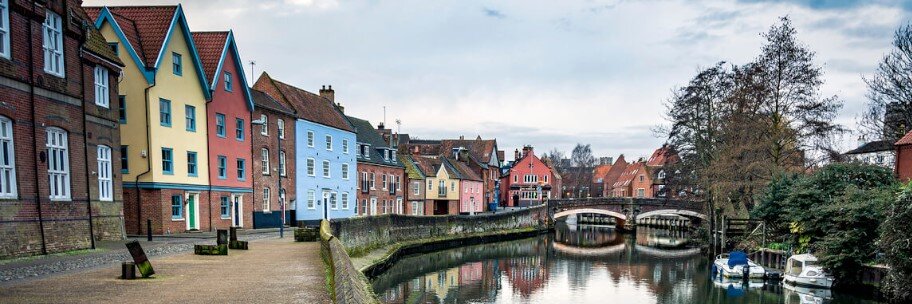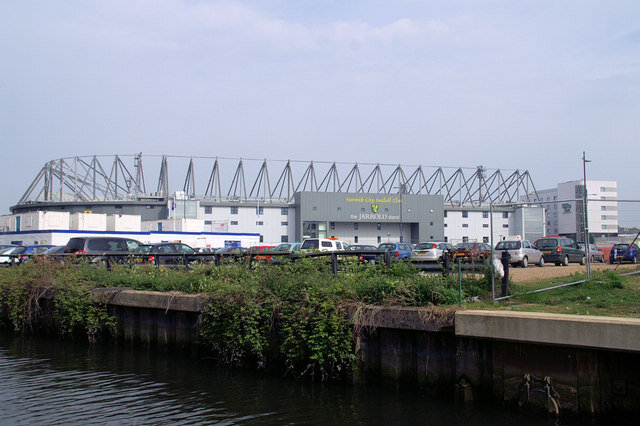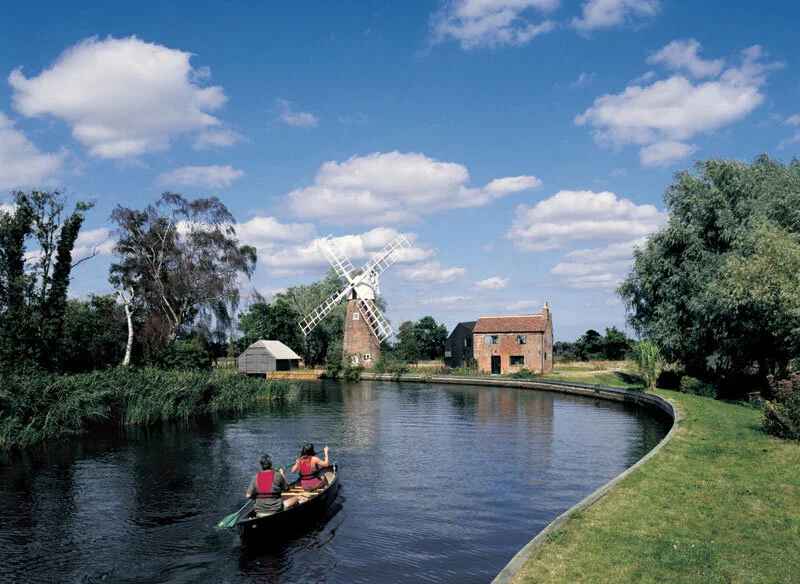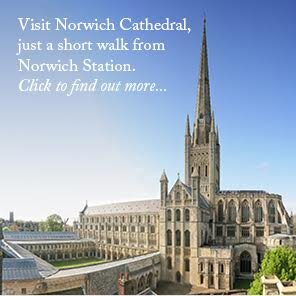
Norwich
Carrow Road. Home of Norwich City
Cathedral
Stranger's Hall
Castle
Elm Hill
Norfolk Broads
CITY
Introduction:
Norwich lies in the centre of Norfolk, on the River Wensum, and is the largest city in East Anglia. Its current population is 132,512.
Brief History:
Starting as an Anglo Saxon settlement and eventually becoming known as North Wic,. the name Norwich first appeared on a coin minted in the 10th Century, at a time when the town grew rapidly. In 1004 the Danes sacked Norwich and left many of their names to streets and places in the town. By the time of the Domesday Book the town had become one of the largest towns in England and continued to flourish into the Middle Ages. Wool, general trades, leather, shoemaking became the staple trades of the population and there were also goldsmiths.
The cathedral was commenced in the eleventh century which led to a hospital being established. In 1404 a mayor was created and a guildhall was built in 1407.
In 1500 the population was 10,000. Fires destroyed much of the wooden buildings in 1505 and 1507 and a plague killed a third of the population in 1579. The population was then boosted to 16000 with the arrival of weavers fleeing persecution from Belgium and Holland.
The 17th Century saw a further surge in population despite two outbreaks of plague. General trading and manufacturing continued throughout the eighteenth century and a newspaper, assembly room and bank arrived. Elizabeth Fry, the prison reformer was born in this era in the city.
Like all cities poverty and slums existed but in the Victorian period sanitation initiatives were introduced and other essentials for a major city were introduced. Trains reached Norwich and engineering, beer and mustard manufacturing were just a few new industries.
Having been one of the country’s largest cities, the industrial revolution did not expand Norwich in the same way as the Northern and Midlands major towns and cities, but is still the main urban area in East Anglia.
The twentieth century saw modernisation (despite 3000 houses being lost through bombing in WW2) with a new university, shopping centres and arts venues.
Further new building works in the 21st Century leave Norwich with a good future in commerce and tourism.
Things to Do:
Cathedral:
With a history stretching to 900 years and some amazing architecture it is not surprising that this cathedral is one of the best to visit.
The spire at 96 metres is only surpassed by Salisbury, in height. There is also much art to be seen and also the fascinating misericords, carvings to the underside of the seats.
Located in Tombland Lane, entry is free (but donations appreciated) and the cathedral itself is open until 6pm daily, refreshments and gift shop until 5pm.
Castle:
Norwich Castle, right in the middle of the city centre at Castle Hill, NR1 3JU, was built as a royal palace by the Normans. Later it was used as a prison and is now the home to a museum and art gallery. As well as permanent exhibitions there are also temporary displays to be seen. Also to be found here is the Royal Norfolk Regiment Museum. Visits to battlements and dungeons are by guided tours only.
Open all year to 4.30pm admission is £8.35 for adults and £6.25 for children.
There is a café and shop.
Strangers’ Hall:
Dating back to 1320 this beautiful building is a maze of interlinked rooms displaying much fine Tudor and Stuart textiles and objects. There is also a Great Hall and great Chamber. Located in Charing Cross, NR2 4AL, it is just a five minute walk from the city centre. Note this building is only open from Wednesday to Friday and Sunday and costs £4.50 admission for adults and £3.40 for children. For enquiries phone 01603 493625.
Elm Hill:
Located just to the north and west of the cathedral, hugging the river, are a group of old streets. They contain many Tudor buildings and Elm Hill is the most photogenic. This street, with a cobbled carriageway, is home to many of the city’s loved institutions, including The Stranger’s Club, The Tea House, Briton’s Arms coffee house and Dormouse Bookshop. It has also been the location for a number of film and TV productions.
It is a very enjoyable area to take a stroll in and absorb the atmosphere.
Aviation Museum:
This museum, located on the A140, Old Norwich Road, NR10 3JF, was set up to preserve and record the history of Norfolk aviation. It contains a wide range of aircraft including a Harrier, Hunter, Lightning, Meteor, Mystere and Vulcan. It is open all year until 5pm in summer and 4pm in winter, with entrance fees of £4.50 for adults and £2.30 for children, with those under 8 having free entrance.
A bus, 44, runs from the city centre, with an hourly timetable. There is a large car park for those who wish to drive to the museum. A cafeteria and shop are also on site. For further information call 01603 893080.
The (Norfolk) Broads:
The Broads are a 117 square miles of rivers and lakes which join Norwich to the sea at Lowestoft and Great Yarmouth. Originally they were thought to be a natural phenomenon but are now understood to have been formed by the excavation of peat. The Broads are very popular for hiring and touring with river cruisers or house boats. There are many firms that hire out these boats. The river side is very pretty and there are many nice pubs and mooring areas along the way.
Colman’s Mustard Shop/Museum:
With over 200 years of mustard making in Norfolk the company is now a Norwich institution. They have a shop in the Art Nouveau Royal Arcade, fitted out as a replica of Victorian premises. The shop and museum are open all year but depending on the season, closing times vary. For further information check out their website at:- info@mustardshopnorwich.co.uk .
Night Life:
A dozen or so night clubs set the scene for a good night out in the city. With a good variety catering for students through to gay clubbers, there is choice for everyone. Prince of Wales Road is the centre of club land.
Interspersed are a good mixture of bars, pubs and casinos.
Four cinema chains, Vue, Odeon, Hollywood and Cinema City, operate in the city area.
For theatre, the Theatre Royal, located on Theatre Street, NR2 1RL, puts on a good programme of musicals, comedy and drama. Their web site is www.theatreroyalnorwich.co.uk where further information can be sought, or by phone on 01603 630000.
Madder Market Theatre in St. John’s Alley, NR2 1DR also puts on a very good selection of drama, musicals etc. They can be contacted on 01603 620917 or by visiting the web site at www.maddermarket.co.uk.
Norwich Playhouse, in St. George’s Street and Puppet Theatre in St. James, Whitefriars, also put on interesting productions.
Eating Out:
With fish in abundance off the Norfolk coast, fish restaurants are worth considering. Otherwise, there are foods from all countries, including Italian, French, Chinese, Indian, Japanese, Lebanese etc. Also, many pubs have good food on sale.
During the day coffee shops, department stores, fast food and cafes, such as the one in The Forum, the city library, are in abundance.
Shopping
Being the main centre of the large area known as East Anglia, all major stores are located in the city centre and retail parks on the outskirts.
Two major department stores, John Lewis and House of Fraser and one large local department store are just the start. There are further national chains, together with local boutiques and specialist shops. Also, not to be missed are the Royal Arcade and the famous Norwich Market which sits right in the main square of the city centre.
Accommodation:
International, national and locally owned hotels, together with guest houses and B&B’s can be found within the city and surrounding area, including Norwich Airport.
Transport:
Buses:
Three dozen routes are operated, by First Group, throughout Norwich its suburbs and Norfolk towns. Most within the city terminate at the bus station in Surrey Street/Queen’s Road. This bus station is also used by other companies. National Express run services to all major cities and airports.
Route 26 connects the railway station to the city centre.
For full details check out www.firstgroup/norfolk.co.uk
Road:
There are no motorways to be found in Norfolk. The main road is the A11 which connects to the M11 just south of Cambridge. This will then take you south to London and south coast or north towards Peterborough and cities up the A1 towards Yorkshire and beyond. Other important roads are the A47 King’s Lynn to Great Yarmouth and the A140 Cromer to Ipswich. Both these roads pass through Norwich.
Within the city there is the A147 Inner Ring Road and the A140/A1042 Outer Ring Road.
Railway:
The station lies to the east of the city centre adjacent to the A147.
The main route is to Liverpool Street Station, London, via Ipswich, Colchester and Chelmsford. Most routes from Norwich to rest of the country go via London with some exceptions. More locally trains run to Great Yarmouth, Ely and Cambridge. For full timetable details contact:- www.nationalrail.co.uk ..
Air:
Lying to the north of the city, on the A140, is Norwich Airport, with scheduled flight destinations to:-Aberdeen, Edinburgh, Guernsey, Jersey and Manchester, in the UK, and Amsterdam in The Netherlands. From the city centre take a bus (check First Eastern Counties website) or taxi, both of which are a twenty minute ride.
Taxis:
Seven taxi companies operate in the city area.
CLUB
NORWICH CITY
Stadium: Carrow Road. Norwich. NR1 1JE
Founded: 1902
Joined League: 1920
Chairman: Alan Bowkett
Manager: David Wagner
Current League: Championship
Phone Number: 01603 760760
Email: reception@ncfc-canaries.co.uk
Brief History:-
Starting life in 1902, they moved to “The Nest” in 1908. At about the same time their own song “On the Ball, City” became the Canaries anthem. The club joined the newly formed Division 3 in 1920, which turned into Division 3 South the following season. In 1930 the club recorded their biggest win, a 10-2 demolition of Coventry City and in season 1933/34 promotion to Division 2 was achieved. The next season they moved to Carrow Road which saw the first game there end as a 4-3 win over West Ham United, watched by a record crowd of 29,779. However, the last season before WW2 the Canaries were relegated back to the third tier.
Post WW2 was not good for the club. They struggled in the League leading to falling back to bottom of the whole Football League in 1956/57. Then fortunes turned around quickly. Season 1958/59 saw the Canaries beat Tottenham Hotspur and Manchester United to reach the semi-final of the FA Cup and then in 1960 a return to Division 2. Year 1962 saw the first Honour when the League Cup was won. The rest of the ‘60s was fairly incident free and then in 1971/72 Ron Saunders’ managership took them to the top flight. A succession of relegations and promotions between the top two tiers occurred during the 1970s and early 1980s and then a further league Cup trophy was won in 1985.
Top flight was achieved again in 1986 and the Canaries stayed there for 12 consecutive seasons. During this period the Premier League was formed and City finished third in its first season. This led to a UEFA cup campaign which saw a win against Bayern Munich but eventual defeat to Inter Milan in the 3rd round.
Delia Smith and her husband took control of the club in 1996 and the team went back to promotion and relegation seasons leading to relegation to the third tier in 2009. The team then suffered their biggest home defeat 1-7 v Colchester United in the first match of the 2009/10 season.
This was a “wake up call” for the club and they went on to successive promotions back to the Premier League. Relegation again in 2014 was followed by promotion back to the top flight in 2015. However, that was short lived as 2015/16 turned into another relegation season.
Season 2018/19 saw City win the Championship title and promotion to the Premier League.
Honours:
League Cup:
1962. 1985.
Match Day:
Tickets:
Away fans should check with their own club regarding tickets.
Tickets can be bought online via the club web site. Alternatively, fans can visit the ticket office at the Aviva Stand at Carrow Road or at the Canary Stores in Castle Mall or Chapelfield shopping centre.
Further information can be obtained by phoning 0844 826 1902.
Transport:
Bus:
From the city centre bus 26 serves the station and Carrow Road.
Rail:
Norwich Station lies adjacent to Carrow Road and is just a 10 minute walk. For train timetable information check out:- www.greateranglia.co.uk
Car:
If travelling into the city by car look for football signs on the A11 and A47 as you drive towards the city and set sat nav to NR1 1JE. There is no car parking at the stadium but spaces can be found at County Hall a ten minute walk away.
Air:
See above if flying into Norwich Airport.
Stadium:
Carrow Road has been home to Norwich City since the mid 1930s.
There are four stands. Norwich and Peterborough is a two tiered stand, originally known as the River End, as it is the closest to the River Wensum. The Barclay stand at the opposite end to the P & N is also a two tiered stand. The Geoffrey Watling City Stand replaced the old City Stand which burned down in 1984. It is single tier, is the smallest in capacity but does house the Directors’ Box, Press area and some hospitality suites. Finally, the Jarrold Stand, sponsored by the local department store, is single tier and holds just over 8000 fans. One end of the stand houses the away fans.
The ground contains various concourses which sell possibly better quality fare than football stadiums normally provide. There is a good selection of local pubs, in the city, between the city and the stadium and around the stadium, such as in the Riverside leisure complex.
Also available are stadium tours, a club store and if staying for a day or two, a very smart Delia’s Restaurant in the Norwich and Peterborough Stand. Contact the club by phone or website for further details.
A national chain hotel is also located on the stadium site.







